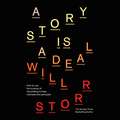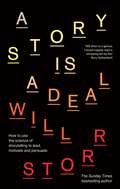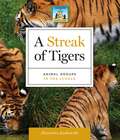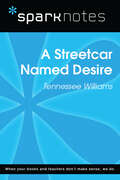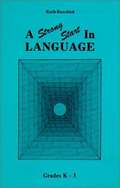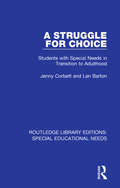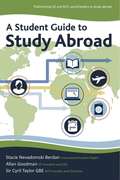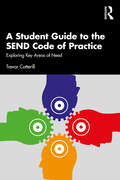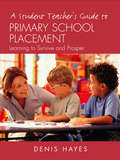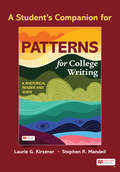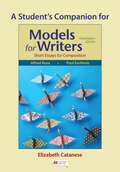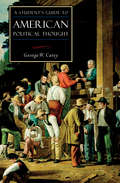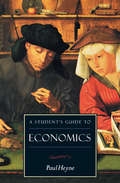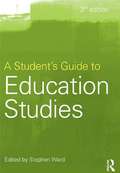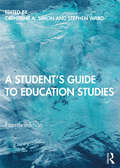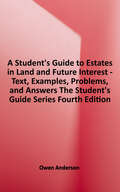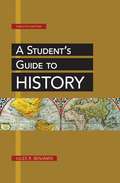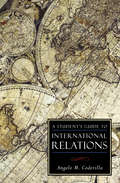- Table View
- List View
A Story No One Has Ever Heard Before
by Avi SteinbergThis hilarious and imaginative debut picture book from The New Yorker cartoonist Avi Steinberg encourages kids to explore their own creativity by telling three wonderfully wild and wacky stories at the same time.Once upon a time there was a story no one has ever heard before, inspired by a carrot on the run, a knight who’d trade his sword for a pal, and an alien who just wants to get some rest and relaxation. It’s a story about how to tell a story.From choosing a main character to crafting a problem to solve to arriving at a satisfying conclusion, readers will learn storytelling tools in this playful, interactive read-aloud.Whimsically witty and gloriously goofy, A Story No One Has Ever Heard Before is perfect for fans of The Book with No Pictures and Dragons Love Tacos.
A Story is a Deal: How to use the science of storytelling to lead, motivate and persuade
by Will StorrIn this highly anticipated follow-up to the Sunday Times bestseller The Science of Storytelling, acclaimed story guru Will Storr shows you how to engage and influence your audience to create irresistible pitches, build passionate brand loyalty, motivate teams and lead with effectiveness and charisma. Using the latest findings from social psychology, evolutionary psychology, organisational psychology and neuroscience, A Story is a Deal argues that we won't unlock the true power of story if we treat it merely as something we read on a page, see on a screen or hear in a speech. Storr shows how successful stories shape identities, which changes beliefs, drives action and achieves extraordinary results. With examples ranging from Aztec rituals to Apple's legendary advertising successes (and long-forgotten fails), A Story is a Deal lays out a revolutionary new method for creating the most persuasive messaging: by harnessing the power of our storytelling brains.
A Story is a Deal: How to use the science of storytelling to lead, motivate and persuade
by Will StorrIn this highly anticipated follow-up to the Sunday Times bestseller The Science of Storytelling, acclaimed story guru Will Storr shows you how to engage and influence your audience to create irresistible pitches, build passionate brand loyalty, motivate teams and lead with effectiveness and charisma. Using the latest findings from social psychology, evolutionary psychology, organisational psychology and neuroscience, A Story is a Deal argues that we won't unlock the true power of story if we treat it merely as something we read on a page, see on a screen or hear in a speech. Storr shows how successful stories shape identities, which changes beliefs, drives action and achieves extraordinary results. With examples ranging from Aztec rituals to Apple's legendary advertising successes (and long-forgotten fails), A Story is a Deal lays out a revolutionary new method for creating the most persuasive messaging: by harnessing the power of our storytelling brains.
A Story is a Deal: How to use the science of storytelling to lead, motivate and persuade
by Will StorrIn this highly anticipated follow-up to the Sunday Times bestseller The Science of Storytelling, acclaimed story guru Will Storr shows you how to engage and influence your audience to create irresistible pitches, build passionate brand loyalty, motivate teams and lead with effectiveness and charisma. Using the latest findings from social psychology, evolutionary psychology, organisational psychology and neuroscience, A Story is a Deal argues that we won't unlock the true power of story if we treat it merely as something we read on a page, see on a screen or hear in a speech. Storr shows how successful stories shape identities, which changes beliefs, drives action and achieves extraordinary results. With examples ranging from Aztec rituals to Apple's legendary advertising successes (and long-forgotten fails), A Story is a Deal lays out a revolutionary new method for creating the most persuasive messaging: by harnessing the power of our storytelling brains.
A Straightforward Guide to Teacher Merit Pay: Encouraging and Rewarding Schoolwide Improvement
by Dr Gary Ritter Joshua H. BarnettReward your best teachers for the great work they do! Is your school system considering teacher merit pay? Now is the time to know the potential pitfalls and learn from the experiences of other districts. Respected experts Ritter and Barnett provide a step-by-step approach to merit pay that draws on best practices from effective, successful programs. You’ll find: A user-friendly summary of existing merit pay programs and their strengths and weaknesses Six essential principles for designing a program that supports teacher professional development, schoolwide progress, and student achievement How-to’s and tools for every phase of program development, including collaborating with teachers to create balanced assessment tools
A Streak of Tigers: Animal Groups in the Jungle (Animal Groups #5)
by Alex KuskowskiWhen some people are together they are called a group. Some animals together have surprising names. For example some wolves are called a pack. In this book you will find out the names of many interesting animals that live in tropical lands where the weather is very hot. A Streak of Tigers is for beginning readers to read with help. The facts in the book are for all ages! Pictures are described.
A Streetcar Named Desire (SparkNotes Literature Guide Series)
by SparkNotesA Streetcar Named Desire (SparkNotes Literature Guide) by Tennessee Williams Making the reading experience fun! Created by Harvard students for students everywhere, SparkNotes is a new breed of study guide: smarter, better, faster. Geared to what today's students need to know, SparkNotes provides: *Chapter-by-chapter analysis *Explanations of key themes, motifs, and symbols *A review quiz and essay topicsLively and accessible, these guides are perfect for late-night studying and writing papers
A Strong Start in Language
by Ruth BeechickEducator Ruth Beechick asserts that children can best learn written language in the same way they learn spoken language. Just as children learn to speak by listening and speaking, they can learn to write correctly by reading and copying good writing. The author explains how home schooling parents can use this "powerful, natural approach" to teach writing, spelling and grammar in the primary grades. Sample lessons are provided. There are also short Bible passages, for writing and spelling practice, as well as character building.
A Struggle for Choice: Students with Special Needs in Transition to Adulthood (Routledge Library Editions: Special Educational Needs #8)
by Jenny Corbett Len BartonFirst published in 1992. For disabled people and people with learning difficulties the transition from school to college, work or training can be stressful and frustrating; job choices are often restricted, and they face barriers which are beyond their control. This book is about their struggle for choice. It sets special needs in further education in a socio-political context. By exploring the concept of ‘transition to adulthood’ in terms of class, race, gender and disability differences, and relating it to social, economic and political influences, it seeks to challenge complacency and encourage dialogue and debate.
A Student Guide to Study Abroad
by Allan E. Goodman Stacie Berdan Sir Cyril TaylorEvery student who wants to succeed in the global economy should study abroad. It is one of the most valuable things you can do for yourself and your career. Each of us has lived and worked both in the United States and overseas, working extensively with both students and employers in a variety of business, academic and not-for-profit settings in our own careers. Stacie Nevadomski Berdan is a seasoned global executive, an expert on international careers, and an award-winning author on how to succeed in the global marketplace. Sir Cyril Taylor has been an innovator in study abroad for nearly 50 years, having founded the American Institute For Foreign Study (AIFS) in 1964, and Richmond, The American International University in London in 1972. As the president and CEO of the Institute of International Education, Allan Goodman is a leader in creating and expanding international educational exchange opportunities, and making them more accessible to more diverse student populations. He was previously a professor and the executive dean of the School of Foreign Service at Georgetown University, teaching students who are now in diplomatic leadership positions around the globe. Together, we and our organizations have advised and supported hundreds of thousands of students over the years to gain an international experience, and we continue to advocate for more students going abroad. We have seen firsthand the value of making international a part of one's education and of listening to others when it comes to adapting to life in another country. We have all felt culture shock and also re-entry problems, and we have seen the impact of an international experience on those who have been fortunate enough to have one. But we realize that not every student knows where to start and how to make it happen. So we teamed up to reach students like you, who are still exploring whether and how to study abroad, and wondering if they should do it. The answer is a resounding "yes"-but only after you have prepared yourself to take full advantage of the opportunity. We wrote this book to give every student access to the best information available on study abroad-things to know before you go, how to make the most of your time abroad, why you should consider internships and career-related experiences abroad, how to transition back to life in the States, and, as you embark on your career, how to use study abroad to showcase your global growth and learning. To bring you current, relevant advice, we surveyed approximately 350 students and asked dozens of educators and business leaders to share their insights. In addition to our own best advice from years of working in international education and communications, we aim to offer you timely and practical feedback from the current generation of students who have made the most of their time abroad. Therefore, we have included more than 200 real-life stories from a diverse collection of students, advisers and professionals, as well as 100 easy-to-follow tips to help guide you through the process. The wide range of programs currently available makes study abroad more flexible, affordable and accessible than ever before. While not everyone can go abroad for a full year in a total language immersion setting, we hope you will agree after reading this book that there is a study abroad option for everyone. We urge you to make international a part of your education.
A Student Guide to Writing Research Reports, Papers, Theses and Dissertations
by Cathal Ó SiochrúThis useful guide for students combines all the guidance, advice and key tips needed to write successful research reports, theses or dissertations, exploring, in detail, each of the elements involved in writing an academic paper. The book will guide you through all the key sections of a report including the introduction, literature review, method, results, discussion and more. Each chapter contains instructions and advice aimed at three different levels of report writing experience – ‘The basics’ covers the basic purpose and structure of each section as well as the most common mistakes, ‘Refinements’ helps you to develop your report writing skills beyond the basics, adding polish and depth, and ‘Advanced’ offers advice and insight into the most complex issues in report writing. In addition to the guidance, there are examples to show you the principles of report writing in action and exercises which allow you to test your understanding as you learn. An essential reference for any student writing an academic paper, A Student Guide to Writing Research Reports, Papers, Theses and Dissertations is the ideal resource to be used as part of your independent study or when working with a supervisor.
A Student Guide to the SEND Code of Practice: Exploring Key Areas of Need
by Trevor CotterillIn this essential textbook for students, Trevor Cotterill delves into the four broad areas of need identified in the SEND Code of Practice (2015), providing a spotlight on current research into a range of identified difficulties as well as outlining the appropriate pedagogical approaches required to support these needs in children and young people. Closely mirroring the SEND Code of Practice (2015), each distinct area of need associated with cognition and learning, communication and interaction, physical and sensory issues and social, emotional and mental health difficulties features essential overviews of research and current thinking within each area. Supported with case studies, learning objectives and reflection points, this text includes discussions on autistic spectrum disorders, profound and multiple learning difficulties, ADHD, mental health, physical and sensory difficulties and adverse childhood experiences as they relate to the SEND Code of Practice (2015). Fully endorsed by evidence-based research involving children, young people, adults and their families, this text encourages students to understand that SEND is a complex area and provides opportunities to reflect on previous experience, harnessing them with knowledge for future practice. Concise yet rigorous in its explanations and coupled with signposted activities and suggestions for further reading throughout, A Student Guide to the SEND Code of Practice will be invaluable to undergraduate students undertaking a programme of study incorporating special educational needs and disability as a single or joint honours.
A Student Teacher's Guide to Primary School Placement: Learning to Survive and Prosper
by Denis HayesSchool experience is the most significant part of learning to be a teacher. It can also be the most confusing, stressful and challenging. Initially, it can be very daunting to walk into someone else's classroom and try to prepare and teach effective lessons to someone else's class.It helps to have a clear idea of what to expect and to know how other people have coped, and in this book, Denis Hayes looks at what life is like for the student-teacher in the classroom. With plenty of down-to-earth and practical advice, he offers strategies for dealing with challenging situations and positive encouragement to help them succeed. The book covers four main areas: principles - summarises the fundamentals of successful teaching placement - provides detailed advice about preparing for, and prospering in, school placements, including case studies of trainee teachers' experiences practice - looks at practical issues in the classroom, including lesson planning, teaching skills, assessment and evaluation, and managing the classroom environment progress - covers applying for jobs and interview strategies, with newly qualified teachers talking about how they managed in their first few months.This text will be invaluable to anyone training to be a primary teacher and about to embark on his or her teaching experience. It will also be a useful resource for teacher mentors and course leaders of BEd, BA (Ed) and PGCE programmes.
A Student's Companion for Patterns for College Writing
by Laurie Kirszner Stephen MandellFor students who need a little extra support, A Student’s Companion for Patterns for College Writing reinforces the most foundational elements in academic writing. This supplement breaks down the steps necessary to excel in college writing while recognizing and respecting students’ abilities. The second edition of this companion volume has been updated to add what instructors have asked us for: more grammar coverage, more sample student papers, and more hands-on practice in the processes of writing and re-writing. It’s the perfect resource for corequisite composition support courses.
A Student's Companion for Patterns for College Writing: A Rhetorical Reader and Guide
by Laurie Kirszner Stephen MandellPatterns for College Writing provides the most support for your writing course, with clear instruction, models of student and professional writing, and essays on topics that resonate.
A Student's Companion to Models for Writers
by Paul Eschholz Alfred Rosa Elizabeth CataneseFor the first time, Models for Writers is available with Achieve, Macmillans new online course space, which includes the complete e-book, auto-scored reading comprehension quizzes, adaptive quizzing, and fully customizable pre-built writing assignments. The short, accessible readings in Models for Writers reflect the length of essays that students write in college and the topics that matter most. This beloved reader is versatile and flexible: it works in a wide range of courses and at various levels. The text is organized to spotlight the rhetorical strategies that students will use in their own essays, as well as the elements and language that will make those essays effective. The Fourteenth Edition includes both classic and new selections on relevant themes such as language and race, smartphones and social media, automation, the rising cost of education, and pronouns and gender. This edition also features an extensively revised Chapter 2 on reading actively and critically and a new Chapter 11 on voice as the writers personality as expressed on the page.
A Student's Guide to American Political Thought (ISI Guides to the Major Disciplines)
by George W. CareyA concise overview of the competing political philosophies that have shaped United States history. Who are the most influential thinkers, and which are the most important concepts, events, and documents in the study of the American political tradition? How ought we regard the beliefs and motivations of the founders, the debate over the ratification of the Constitution, the historical circumstances of the Declaration of Independence, the rise of the modern presidency, and the advent of judicial supremacy? These are a few of the fascinating questions canvassed by George W. Carey in A Student&’s Guide to American Political Thought. Carey&’s primer instructs students on the fundamental matters of American political theory while telling them where to turn to obtain a better grasp on the ideas that have shaped the American political heritage.
A Student's Guide to Classics (ISI Guides to the Major Disciplines)
by Bruce S. ThorntonBruce Thornton's crisp and informative Student's Guide to Classics provides readers with an overview of each of the major poets, dramatists, philosophers, and historians of ancient Greece and Rome. Including short bios of major figures and a list of suggested readings, Thornton's guide is unparalleled as a brief introduction to the literature of the classical world.
A Student's Guide to Economics (ISI Guides to the Major Disciplines)
by Paul HeyneWhat makes economies work—or not work? This concise overview of the field&’s great thinkers offers a wealth of information. Paul Heyne, one of the nation&’s best-selling economists, provides an accessible overview of the discipline of economics. Economic knowledge, he contends, is not complete without reference to the totality of human society—a realization essential to a proper understanding of the fundamental principles of economics. The sweep of economic thinking is presented here with reference to the great economists and important schools of thought.
A Student's Guide to Education Studies
by Stephen WardA Student’s Guide to Education Studies is a much-needed resource for any undergraduate making their first explorations into the fascinating world of education. The first publication of this book in 2002 helped to define the nature of the subject, introducing topics into the field which had not been previously considered. This new edition brings the subject up to date with the latest thinking and research on policy, globalisation, learning and knowledge,?offering an accessible and wide-ranging introduction to a diverse range of topics and issues in education. Now fully updated to reflect rapid and significant changes in the field, this third edition considers topical issues including: the political dimension of education, the national debate about schooling and poverty, the marketisation of education, the end of Every Child Matters, the Coalition Government’s policies for academies and free schools.? Organised around three enduring themes - Education Policy and Politics, Global and Environmental Education, and Learning, Knowledge and the Curriculum - each chapter contains summary points, questions for discussion, and annotated suggestions for further reading. With a distinctive international and global focus, A Student's Guide to Education Studies is an essential resource for all students of Education Studies.
A Student's Guide to Education Studies: A Student's Guide
by Stephen Ward Catherine SimonThis new edition of A Student’s Guide to Education Studies is an essential resource for any undergraduate making their first explorations into the fascinating world of education. It explores a wide range of alternative visions of education encouraging students to challenge the perceived notions about learning and knowledge. Offering new perspectives and powerful ideas for discussion on a variety of long-standing topics such as class, race and gender, the book is organised around five enduring themes: Policy and Politics, Global and Environmental Education, Knowledge and Learning, Childhood and Youth, Professionalism and Employment. With a distinctive international and global focus, this new edition has been extensively updated to reflect the latest research and thinking in the field and features new chapters on: The sociology of education and the philosophy of education Inclusion Childhood and youth Professionalism and work-based learning Populism in politics Including summary points, questions for discussion and annotated suggestions for further reading, this book provides the theoretical background needed to carry out a critical analysis of education policy and practice and is an essential resource for all students of Education Studies.
A Student's Guide to Estates in Land and Future Interests: Text, Examples, Problems, and Answers, Fourth Edition
by Owen AndersonThis unique self-teaching guide facilitates the understanding of complex materials from property courses. Chronologically organized material familiarizes students with basic concepts and necessary technical vocabulary. The author graphically explains complex concepts and provides extensive problem and answer sets. Topics include basic possessory estates, remainders, and executory interests in response to the statute of uses, modifications of the common law scheme, and interesting complexities and modern changes.
A Student's Guide to History
by Jules R. BenjaminThis guide provides comprehensive coverage of the historian's research process from formulating a research question to how to find, evaluate, and work with sources of all types written and nonwritten, in print and online. The writing process is explained thoroughly as advice on creating a strong thesis and writing an effective paper culminates with a model student research paper.
A Student's Guide to History (4th Edition)
by Jules R. BenjaminThis compact, best-selling introduction to the study of history equips students with all the skills they need to succeed in a history course. A thoroughly class-tested guide through eight editions, the ninth edition provides students with even more practical tools and features -- including new, hands-on exercises -- that reinforce basic skills and explain tricky issues, saving instructors valuable classroom time.
A Student's Guide to International Relations (ISI Guides to the Major Disciplines #4)
by Angelo M. CodevillaA concise journey through geopolitics and the continuing debate about America&’s role in the world. Terrorist attacks, wars in Afghanistan and Iraq, the rise of China, and the decline of Europe have underscored the necessity of understanding the world around us. But how should we approach this crucial but often misunderstood topic? What do we need to know about the international order and America&’s role in it?A Student&’s Guide to International Relations provides a vital introduction to the geography, culture, and politics that make up the global environment. Angelo Codevilla, who has taught international relations at some of America&’s most prestigious universities, explains the history of the international system, the dominant schools of American statecraft, the instruments of power, contemporary geopolitics, and more. The content of international relations, he demonstrates, flows from the differences between our global village&’s peculiar neighborhoods. This witty and wise book helps make sense of a complex world.

